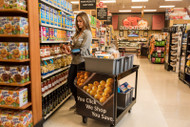How Supermarkets & Retailers Are Adapting To A Contactless Shopping Experience
Published by labelmanadmin on 17th Apr 2020
Supermarket and retail customers are increasingly utilising the click and collect services offered to them, especially in more recent times. This grab and go service is efficient, easy and convenient.
Zebra’s 2020 Shopper Study shows that the demand for online shopping will be increasing over the next 5 years. However, with the COVID-19 infection hitting the country, the demand for online shopping has hit an all-time high, which nobody could have been prepared for.
Billions of people will be adapting to this new method of shopping. This is expected to carry on after the pandemic has passed but are the supermarkets and retailers prepared for this spike in demand? As most of you may have experienced, receiving a delivery slot is proving to be very difficult at the moment. Retailers and Supermarkets are having to put all their efforts in to keep up with the orders and ensure there is stock and availability, alongside ensuring they are adhering to the social distancing government guidelines.
Retailers and supermarkets are now looking for ways they can accommodate a ramp up in click and collect orders. Including ensuring there is space around the store for people to effectively have a shopping ‘drive through’ experience with minimal social contact amongst other factors.
The main areas that have been found to increase the shops efficiency and customer service are as follow;
Storage:
It has been found that it is becoming increasingly difficult to store orders that have been picked a few hours before the delivery slot, mainly for frozen or cold goods and not having the space to hold these until their allocated dispatch time. Many stores have found that by introducing outside lockers, refrigerators and freezers for cold goods, has helped to solve this problem and restrict the amount of social contact. Orders are placed in an allocated storage unit outside and the customer simply drives up to unit and retrieves their order. To ensure minimal contact in this current climate, contactless ID verification and loyalty card scanning could be implemented at this stage.
Communications:
Currently, if you were to place a click and collect or home delivery order, once you have clicked ‘place order’ and paid for your goods, you will not expect to receive any communications for the shop until your order is being dispatched or is ready to collect. This can cause dissatisfaction for the customer, especially when part of the order later becomes out of stock and, in some cases, substituted for an alternative product left at the discretion of the picker. Introducing Handheld Computers in to your stores can give the customer and the staff member more control over their orders. Being able to communicate quickly and effectively with the shop will bring the customer more satisfaction with the level of service they are receiving.
Payments:
Ensuring that your customers have a contactless payment option is top priority. If customers are unable to pay online at the point of placing the order, measures should be taken to accept ‘tap and pay’ payments or the ability to swipe the payment card on a handheld computer or tablet with the member of staff able to sign on behalf of the customer.
Arrival Location/time:
When a customer arrives to collect their order, a member of staff will need to be notified to direct them to their designated unit that contains the order, or for the staff to be able to locate the customer so that they can deliver their goods to them. You could introduce a push-notifications through the app with a QR code that is scanned at a kiosk, where the location of there goods is sent back to the customer, or a notification sent through to the staff to alert them that the customer is ready to collect their goods.
Zebra have introduced all kinds of innovative technology to help ensure retailers and supermarkets are fulfilling their customer demands in this challenging time, including the Zebra SmartSight which is currently being used in supermarkets around the world.
For further information, please contact us.
